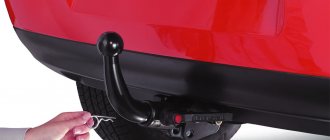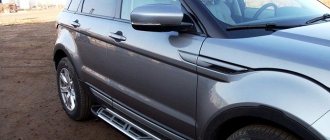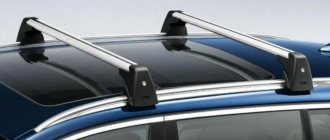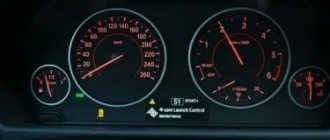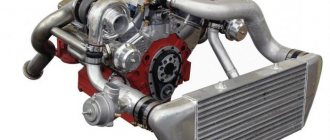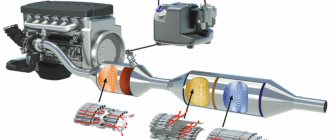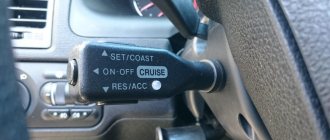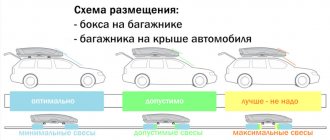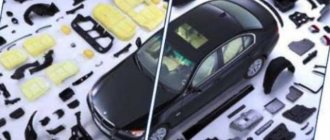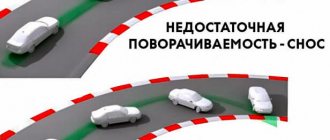Corrosion on a car body is a real problem for many car owners. For example, if you need to save your car and, accordingly, protect the metal of the body from atmospheric corrosion processes. Today there are several options for such protection - this is a passive method, active, and also transformative.
In the case of the active method, special protective compounds are used that create stable compounds on the metal surface that protect the body from corrosion processes. One of the most famous and popular drugs of this kind is the drug “Movil”. What it is? This is a mixture of motor oils, drying oils, and inhibitory additives. The composition also contains solvents - white spirit or kerosene. This preparation forms a dense combined film on the metal surface that does not allow oxygen and water to pass through. And these are the main factors that cause iron to rust.
Moscow-Vilnius
Many car owners use Movil, however, not all of them know that it is a domestic development.
This composition was developed by a group of scientists from Vilnius and Moscow. At that time, Tektil-309, developed by specialists from Sweden, was used for anti-corrosion treatment in the USSR. "Tektil-309" was especially popular, but it was created by Soviet scientists and was in many ways superior to the Swedish product.
Operating principle
The anti-corrosion or preservative agent "Movil" has a principle of operation based on the most complete sealing and insulation of metals. This makes it possible to be in close contact with air and moisture, which are the main cause of corrosion on bodies. In addition, thanks to the inhibitor, this composition immediately after application begins to actively fight pockets of corrosion.
For car enthusiasts this is a big plus. Treatment with Movil can be carried out without the need to remove bitumen mastic. When the composition is applied to such insulating materials, it tightly covers the surface and passes through the protective layer directly to the metal through various cracks - this is guaranteed insulation of the metal from corrosion. If corrosion processes have already started, then with the help of Movil you can stop the growth of rust.
If you need to park your car for a long time, experts recommend treating the body with this composition as much as possible in all places, so that then, after the expiration of the storage period, you can take the car from the parking lot in its original form.
But when using this preservative, you need to remember that it is incompatible with various synthetic-based mastics. If Movil begins to interact with such mastics, they will begin to loosen, followed by peeling off from the metal surface.
It is not recommended and even prohibited to use the drug if there is a risk of it getting on rubber parts. Due to the substances included in the composition, rubber will quickly become completely unusable.
What is "Movil"?
Many motorists call any anti-corrosion agent for a car Movil, but this is incorrect. The original Movil contains the following components:
- Engine oil.
- Drying oil.
- Anti-corrosion substances.
If an anti-corrosion drug has a different composition, then it cannot be called Movil. A product for protecting the body from rust, under the original name “Movil,” was simultaneously developed by research institutes located in Moscow and Vilnius, for which it received its name from the first letters of these cities.
Anticorrosive agent was invented in the last century, but despite the huge range of various anti-corrosion agents available on the Russian market, this anti-corrosion agent is still in high demand among car owners today, due to its low cost and high quality.
To know which Movil to choose for your car and how to use this anti-corrosion agent, you need to determine what type of rust preventative to purchase for treating the body.
Types of anticorrosive
Types of Movil for cars are presented in 3 categories:
1. Aerosols are the most popular and convenient means for applying anti-corrosion composition.
The price of a 520 ml can ranges from 200 to 300 rubles. Treating the car body with such packaging will cost the motorist much more, due to the gas inside the canister, which is used for spraying.
The inconvenience of using this type of anticorrosion agent may also lie in the need to keep the canister in a vertical position, so for anti-corrosion treatment it is better to purchase a canister equipped with a special tube with a spray at the end.
2. Liquid Movil is an inexpensive option for use as an anti-corrosion treatment. The cost of a 3-liter canister is only 300 - 400 rubles.
The consistency of the liquid composition allows for effective treatment of hidden cavities. The product is easily applied to thresholds and internal door cavities. You can get the most even distribution of the substance inside hidden cavities using an original spherical nozzle, which allows you to process every square centimeter of the internal area of the metal elements of the body.
3. Paste-like Movil, most often sold in tin or plastic packaging, in the form of cans.
The cost of such a drug for treating a car is about 200 rubles. per package weighing 0.86 kg. The product is applied to the surface to be treated with a brush, and to treat internal cavities it is diluted with a solvent.
After a vehicle body treatment product has been selected, it is necessary to thoroughly prepare the body surface on which the anti-corrosion compound will be applied.
Preparing the car
The underbody of the car is most often subjected to anti-corrosion treatment. This part of the body is most susceptible to destructive processes, especially when the car has to be operated in high humidity.
Mechanical damage from stones and sand from under the wheels also causes significant damage to the lower part of the car body. The following body elements are subjected to anti-corrosion treatment using Movil:
- Spars.
- Floor thresholds.
- Door pockets.
- Front and rear arches.
- Central pillars.
- Headlight covers.
All listed places must be properly prepared. First of all, it is necessary to thoroughly clean the surface to be treated from dirt and dust. For this purpose, you can use a portable car wash with the addition of special detergents that will clean the surface not only of dirt, but also of oily deposits.
After thorough cleaning. The surface on which Movil will be applied must be free from moisture. If the treatment is carried out in the summer, then it is enough to dry the car in the open air for several hours. In cold or damp seasons, you need to use a compressor to remove moisture. Blowing with compressed air will reliably remove moisture from the surface, after which it will be possible to apply the working solution to the metal surface without any obstacles.
After cleaning the surface of the underbody of the car from contamination, you should inspect the paintwork of the lower part of the body. If areas of paint peeling or swelling of the paint are identified, then such areas must be cleaned with a wire brush or coarse sandpaper. If pockets of rust are found on the underside of the car, such places must also be properly treated before applying Movil.
You can also use sandpaper or a grinder to remove corrosion.
When the metal surface is cleaned, it should be treated with any rust converter in order to stop the destructive process in the metal.
After completing all preparatory procedures, you can begin directly applying the anti-corrosion composition to the underbody of the car.
How to apply Movil
Do-it-yourself car treatment with Movil can be done in a garage, without the need to use expensive equipment. What body treatment tool you will need to apply the anti-corrosion agent depends on its consistency.
Liquid Movil is much more practical to apply using a sprayer. If it is not possible to use a liquid product or you don’t know how to dilute the Movil to the desired consistency, you should use a small brush.
If you need to dilute Movil, then this is not difficult to do. For this purpose, you can successfully use “White spirit” or “646” solvent.
The anticorrosive agent is applied to the previously prepared surface in an even layer. The vehicle can only be operated a few days after the anti-corrosion treatment has been completed.
Precautionary measures
- Movil contains substances, inhaling vapors of which can cause poisoning, so it is recommended to carry out work outdoors or in a well-ventilated area.
- In order to be able to safely use the car after application, you also need to know how long Movil takes to dry. The anti-corrosion agent takes a very long time to dry, so an unpleasant odor will be felt in the car interior for at least 3 days. To avoid poisoning from solvents and other volatile substances, after applying the substance, you should stop driving the car for several days.
- In addition to vapor poisoning, during treatment you can get burned from contact of the working composition with exposed skin or eyes, so it is recommended to carry out anti-corrosion work in closed clothing and gloves. And when using aerosol cans or a spray, wear safety glasses.
PS It can be difficult to decide which Movil to choose for your car. The market for spare parts and auto chemicals is very attractive for dishonest citizens who, for the sake of profit, produce low-quality fakes and sell them in the vast expanses of our country.
To protect yourself from purchasing a low-quality anti-corrosion treatment product, when choosing an anti-corrosion treatment, you should rely on reviews from acquaintances and friends who have already used this product to treat a car.
Advantages of Movil
The product can be applied both to unpainted metal surfaces and to any coatings treated with varnishes and paints. After metal processing there is no need for drying. As a result of application, a reliable protective layer is created that not only prevents moisture from reaching the metal, but also repels it. Other advantages include the absence of a negative effect on metal and any paints. All this makes the product quite effective in combating corrosion. Many car enthusiasts successfully use Movil. What it is? This is a powerful weapon for fighting rust.
This drug is simply irreplaceable when you need to defeat pockets of corrosion in hard-to-reach areas of the machine. It differs from other products in its high fluidity - the substance easily penetrates even into minor cracks and cracks.
Precautionary measures
application When carrying out work, it is necessary to ensure good ventilation, as well as take fire safety measures, since Movil contains highly flammable components. Avoid contact with the skin and especially the mucous surfaces of the eyes or nasopharynx, otherwise you should immediately consult a doctor.
You should avoid getting Movil on plastic and rubber parts, as it has a negative effect on them. The drug is completely safe for paintwork, but stains of hardened Movil are difficult to remove. Therefore, care should be taken when applying.
In order to avoid a situation where excess Movil flows onto the garage floor (in addition to the obvious sanitary disadvantages, it is also a flammable material), it is recommended that at least 24 hours after treatment, leave the car for several hours in the sun or in a room with a temperature above 25 degrees, having previously placed it on polyethylene. As already mentioned, under the influence of high temperatures the Movil will soften and the excess will flow through the drainage holes in the cavities, after which they can be closed.
It should be remembered that to ensure effective protection of the metal, it is necessary to inspect the condition of the anti-corrosion coating every few months. If Movil for a car has hardened, lost its plasticity and even cracked, it is urgent to repeat the processing procedure with careful adjustment of its composition. To remove the old layer, you can use the same solvent that was used when selecting the consistency, or a product for removing bitumen stains.
Thus, subject to all rules and requirements, Movil is able to provide your car with reliable protection for little money. This automotive preservative can still guarantee a high level of corrosion resistance of your car body at the level of foreign analogues.
Good afternoon. The topic of today’s article is do-it-yourself anti-corrosion treatment of the body; in the article you will find recommendations for anti-corrosion treatment of hidden cavities and preserving the paintwork for as long as possible to prevent external corrosion.
Anti-corrosion treatment of hidden body cavities.
The rotting of an undamaged car always begins with hidden cavities in the body. They are filled with dust and dirt, all this is wetted with water and a favorable environment for corrosion is obtained.
Therefore, before choosing an anti-corrosion compound, it is necessary to rinse and dry the hidden cavities. This is done like this:
After this, you have a fork of 3 options with approximately the same efficiency, but different labor costs:
- Flush cavities with drainage at every oil change.
The option is quite excellent, and if you do it yourself, it’s free! And the option is quite labor-intensive since you will have to open the lids and add oil 2-4 times a year! It's a lot! But with regular treatment, the car will not rust, since the oil film on the metal blocks the access of water and air to it, and accordingly, even the corrosion that has begun is slowed down.
Among the disadvantages, used oil contains harmful substances, and when they evaporate, they can have a negative impact on the health of the driver and passengers. But during the Soviet era, many cars were spilled and nothing bad happened... An excellent alternative to mining is Crude OIL. Yes, it contains a lot of sulfur and impurities, but it is almost impossible to wash it off.
- Cheap domestic products such as "Movil"
Movil is a mixture of lithol, motor oil, drying oil, kerosene and corrosion inhibitors. The principle of operation is exactly the same as that of working off - to limit the access of water and air to the metal of the body. Unlike mining, it is more expensive, but it needs to be updated less often - once a year will be enough.
How to prepare a car for processing?
First you need to prepare the surface and then apply Movil directly. What it is? This is a simple preparation that will make the drug even more effective.
First of all, the car must be thoroughly washed. If you plan to treat the bottom, then it is washed while the car is on the lift. It is best to use a pressure washer with hot water. After the procedure, the body must be thoroughly dried.
Next, various defects that exist on the metal surface are eliminated. Loose rust should be removed. Then an anti-corrosion agent is applied. When the product dries, a protective film with a layer of 40 to 60 microns will begin to form.
How to use Movil
To get the most out of this preservative, you need to know how to apply it correctly. Metal processing is carried out using a special tool - this is a gun through which the drug is sprayed.
Thanks to spraying under pressure, Movil penetrates into any cracks and cavities that are already corroded or those that need to be protected. Open areas can be treated with a regular brush.
After treating the area, the surface is degreased. It is best to spray the drug at temperatures from 10 to 30 degrees. A more effective option is to apply several, preferably 2-3 layers.
It is important that Movil is applied in an even layer. First, the trunk or doors are treated. Then they look at how it spreads. After this, it will be easier to understand how to continue working so that the product does not drip onto the ground.
To process a square meter of metal in one layer you will need about 400 g of Movil. Drying time is about 2 hours. The product can be supplied as a mass in a plastic container. There is also Movil-aerosol, but the disadvantage of such packaging is its small volume.
If the product accidentally gets on the paintwork, it will be very difficult to clean it. If there are drops on the paint, they are removed immediately (until they harden). If there are any plugs on the body, it is better to remove them so that the anti-corrosion substance can easily get into any places.
Bottom treatment with Movil
The bottom of the car is a platform for assembling other body elements, so it must be strong enough. The metal bottom undergoes anti-corrosion treatment at the factory, but natural or physical factors have a detrimental effect on the protection of the metal, and over time, the treatment has to be repeated.
So, let's look at the sequence of actions. After you have pre-washed the car, place it on an inspection hole or overpass. This is done for your convenience in performing bottom treatment operations. The bottom of the bottom is often poorly washed during standard car washing, so most likely you will have to repeat the procedure separately for it. Then start cleaning the metal until it shines. This should only be done in places that have rust showing through, swelling, or a completely rotten hole.
In the latter option, you cannot do without welding. You can prepare the place yourself; to do this, you first need to use a grinder to cut off all the rot down to the living metal, then clean the place with a drill or grinder with a specially wound cleaning wheel. You can also use sandpaper. After welding work, the area should be re-primed, having previously degreased it.
Full vehicle primer before anti-corrosion treatment
If you only have rust, then it is enough to clean it with sandpaper and re-prime it as well.
After these procedures, you need to clear the bottom of unnecessary items to properly cover the surface. You will be in the way of the exhaust pipe and, on some car models, the fuel tank. If you have an LPG installed and it interferes with access to the bottom, then, of course, it will also have to be dismantled. When removing a particular fuel tank, do not forget to turn off the fuel supply valve to the system. This is especially true for gas equipment - do not forget that you need to act extremely carefully.
Treating the underbody of a car with Movil
After completing these steps, rinse the bottom thoroughly again. Then wait a couple of hours for it to dry, and you can start applying the anti-corrosion Movil. Apply it slowly, in an even layer. After application, the product dries for 1-2 hours. Then all you have to do is put everything back together and the job is done.
You can watch the video for more information about processing the bottom with Movil:
"Movil 2M"
This is a domestic product. The company is located in Moscow. The drug is supplied in a can. After processing, a thin transparent and fairly uniform film is created on the surface. This product withstands the Russian winter well. If a drop of this composition gets on the paint, it can be easily removed with gasoline. The product impregnates rust and has medium fluidity.
The product displaces water well, but the protective layer is not very strong, which means it is ineffective. Sooner or later, rust will still appear. Motorists say that it is better not to use it - it is a waste of money.
Technology: how to use Movil solution to protect cars and precautions
To complete the work, it is important to select the consistency of the mixture by adding a solvent. It must be remembered that the fluidity of the solution depends on the ambient temperature; 20°C is considered optimal. The treatment procedure using an aerosol looks much simpler, because the mixture is already in working condition.
Treatment of easily accessible areas
For those who are interested in how to use Movil anticorrosive for cars in easily accessible places, you should familiarize yourself with the following points:
- Prepare the surface by removing dirt and loose layers of oxides.
- Degrease the work area and dry it.
- Apply the first layer of anticorrosive with a roller or brush. If an aerosol is used, the can should be shaken several times beforehand. The solution is fed through the spray head.
- Dry and apply a second and, if necessary, a third layer with intermediate drying.
- The coating dries completely within 24 hours; it is not advisable to operate the car during this period.
Important! If preservative gets on the surface of the paintwork, it must be quickly wiped off with a cleaner for bitumen stains.
Treatment of hidden cavities
The operation has its own characteristics and proceeds according to the following scheme:
- Remove elements that interfere with the work process.
- If there are drainage holes, rinse the cavities thoroughly.
- Treat the cavity with a rust converter and rinse after a while using an alkaline reagent.
- Dry the closed cavity with a stream of warm air.
- Connect the flexible tube from the kit to the cylinder; if the cylinder is designed to work with a gun, then install it in its regular place.
- Insert the end of the tube or gun into the technological hole and spray the anticorrosive agent.
"Movil" long-drying
This product is better than ordinary Movil and any of the anti-corrosion protection products offered on the market. In the case of conventional drugs, the downside is the smell. The consistency of this product is not thick, but not too runny either. After treatment, a durable film is formed on the surface.
The manufacturer recommends applying the product in several layers using a brush. It is imperative that they have time to dry. The difference between this particular product and all others is its elasticity. It will not fall off even under mechanical stress.
"Movil" with rust converter
These products are available in aerosol and liquid form. The purpose of the product is not only to protect against corrosion, but also to transform existing lesions. But there is one nuance here - in fact, its composition is no different from the usual Movil.
Such products are classified as petroleum-based film-forming inhibited compounds. It gets deep into the pores of the corrosion, and the converter transforms the corrosion into a form of steel that does not rust. Additionally, a protective film is formed, which prevents further oxidation.
Which Movil is cheaper?
Today, Movil aerosols, which contain a rust converter, are in approximately the same price range - about 300 rubles per liter. The final price may vary depending on the region where auto chemicals are sold and the amount of anticorrosive agent purchased. Traditionally, products in small packages are a little more expensive.
Liquid products cost about half as much as aerosols (about 150 rubles per liter). If you plan to apply the product to the surface to be protected using a brush, then there is an opportunity to save money. The liquid can also be applied with a sprayer.
We recommend: Tourmaline, rubber, magnetic balls for washing clothes - a revolution in the washing machine
